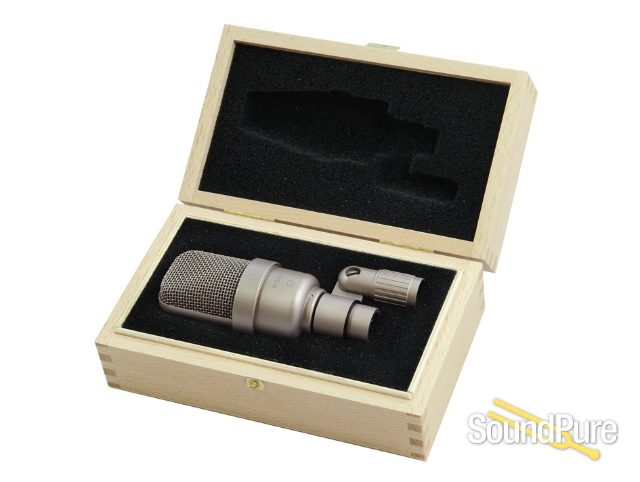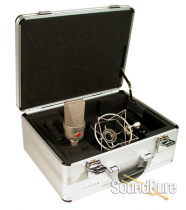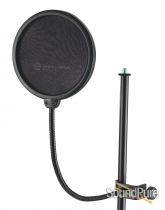-
Call Us Toll Free888-528-9703
-
Local/International (+1)919-682-5552
- Call Us! Toll Free! 888-528-9703
- Local / International (+1) 919-682-5552

$1,308.00
"Experience the Difference"
 Payments as low as $29/mo.
Payments as low as $29/mo.
888-528-9703
sales@soundpure.com
Manufacturer's Description from Gefell
The M930 is a compact, large diaphragm microphone that combines the latest Gefell M9 gold evaprated capsule with an optically isolated capsule amplifier for low self-noise, excellent dynamic handling and the added benefit of greater placement ease. Available in choice of cardioid (M930) or hypercardioid (M940) models, these " Gefell gems" are also available in stereo matched kits complete with choice of XY or ORTF mounting hardware.
Design Features
On first view, one is immediately amazed at how compact the M930 is. But even more amazing is the incorporation of the M9, a full-size 1-inch (25mm), 24-karat gold evaporated diaphragm. The M9 features a hand stretched Mylar/PE substrate with a hand-drilled solid brass back-plate. All Gefell capsules are individually sorted and matched for optimum voicing.
The M9 is mounted on a triangulated pedestal that deflects unwanted body reflections away from the diaphragm, reducing phase cancellation and the effects of comb-filtering which can mask harmonic details and limit the depth of field. To reduce noise from vibration, the microphone capsule and electronics are elastically suspended inside the compact metal housing. This reduces the sensitivity to mechanical impact and structure born noise. This of course is further advantaged by the M930's diminutive size, which has the net result of less "vortex" or acoustic disturbance around the mic.
But creating a smaller body is not without challenges: As everyone knows, smaller usually means bringing the circuit closer to the sensitive element. If left unchecked this would result in an unacceptable noise floor. The M930 overcomes this technical challenge by introducing optical isolation between the 48-Volt phantom power supply and the internal capsule amplifier circuit. Optical isolation removes "hash" caused by contamination and ripple from the power supply, providing a pure DC supply to the element. The M930 benefits with improved voltage stability and significantly lower self-noise.
Below the capsule, an innovative circular PC board using the very latest semiconductor technology houses the electronic impedance converter. A newly perfected transformerless circuit topology reduces the noise floor to an extremely low level and minimizes RFI susceptibility, while also raising the maximum output capability. Furthermore, the use of large, oversized capacitors provided added storage for exceptional transient handling. As a result, the Gefell M930 produces a clean, distortion-free sound over an extremely wide dynamic range.
Using the M930
The Gefell M930 is a cardioid microphone that connects using a standard 3-pin XLR mic cable with 48V phantom powering. It comes equipped with a machined brass mic clip for use on standard mic stands or in conjunction with stereo bars for XY, ORTF and other recording systems. To further reduce noise from vibration, the optional EH93 isolation mount is recommended. This combined with the internal shock mounting assures noise-free performance in even the most challenging environments.
As a side address microphone, the pick-up pattern is perpendicular to the direction of the microphone axis. It should be noted that the model number and pick-up pattern symbol mark the front of the microphone. The M930 exhibits a smooth frequency response with a slight presence rise from 7kHz to 11kHz adding detail and articulation. This is especially useful for voice and instrument recording where ambient clutter may be present.
The polar response exhibits an exceptionally high degree of rejection for sounds impinging from the rear or sides of the microphone further advantaging the M930?s performance. This of course has the added benefit of reducing feedback in live sound reinforcement. For even greater rejection, one would select the Gefell M940, the hypercardioid version of the M930. The M940 further suppresses side and rear borne noise making it ideal for use in very high noise environments.
The M930's compact size and excellent SPL handling capacity makes placement easy, unrestricted and unobtrusive. This greater flexibility gives rise to more creative uses for the mic opening doors to applications that up until now have either been impossible to achieve or were compromised.
When using the M930 for close micing a voice, the use of a pop-filter or the W76 windscreen is recommended. This allows the engineer to take full advantage of the warm sound caused by the proximity effect and the on-axis presence rise as one nears the capsule.
Interpretation
The Gefell M930 is a unique microphone that sets a new standard for signal to noise performance while retaining the warm musical character and extended frequency response that has made Gefell a legend.
The combination of small size, low noise and excellent impulse response opens the door to all types of applications including vocalists, announcers, dialog pickup, and as a spot microphones for recording guitars, keyboard, percussion, wind and string instruments. This universal appeal makes the M930 a prime contender for commercial studios and broadcast, while the mic's relative affordability makes it a "must-have" for the top-end project studio.
Both the M930 and M940 come standard in a satin nickel finish but may be specially ordered in a dark bronze finish that is optimized for on-camera use. These come standard with mic clip in a deluxe dovetailed wood storage box.

About Manufacturer
Since its founding by Georg Neumann in 1928, the company has produced high quality, condenser microphones for broadcasting and recording. Many models have used the M7 capsule originally designed by Mr. Neumann in 1949 for the CMV563a. The M7 was responsible for the legendary sound of the Berlin manufactured U47, U48 and M49 microphones. Today, under the technical supervision of Mr. Kuehnast's son, the Company still produces the M7 capsule in exactly the same way Mr. Neumann taught the elder Kuehnast in the 1940's. Hand drilling each hole in the backplate, making the PVC membrane, and even gluing it together by hand is done just as Mr. Neumann specified. The M7 is currently used in the UM 92.1S, UMT800, UMT70S and MT71S Gefell manufactured microphones.
Some of the production equipment which Microtech Gefell GmbH uses for capsule production capitalizes on advanced technology developed by the Soviets before Perestroika. One of the more recently developed microphones, the M300, uses a capsule made of ceramic material molded under high pressure and plated with chromium. This technology was developed in Moscow using advanced computer modeling and simulation techniques. Gefell perfected a capsule manufacturing process unlike any employed in making Western microphones.
The SMS70 series of microphones designed in the early 1970's used a hybrid amplifier with an fet stage. Hybrid technology was not adopted by manufacturers of Western microphones until the late 1980's. Microtech's newest amplifier for the UMT70S series microphones uses surface mount device (SMD) technology.
The company also manufactures a complete line of measurement microphones equivalent to those of Bruel & Kjaer, the Danish manufacturer. These microphones are tested to the highest standards currently used in the West. The manufacturing methods for the nickel membranes and backplate assemblies are highly advanced. Testing each microphone takes a minimum of three months to guarantee performance and stability when it leaves the factory.
Before the Reunification of Germany the company manufactured their studio and broadcast microphones for RFT, a state agency that distributed them to customers in the Eastern Bloc. Most of the microphones went into the broadcast system. Some microphones, like the PM 860, went into public address systems. Virtually every town hall and auditorium in the former Soviet Union has one. About 1985, the Company began developing high powered (30 to 100 Watt) industrial lasers. They still use a laser engraving machine to put the name and serial numbers onto microphones and other finished metal products. During this period, the East German government poured 60 Million Ost Mark into the company allowing them to buy sophisticated equipment and construct a new building.
Specifications
Pattern: Hypercardioid
Response: 40Hz ~ 18kHz
Sensitivity: 23mV/Pa
Self noise: 6dB-A
Signal to noise: 87dB-A
Maximum SPL: 141dB
Dynamic Range: 103dB
Power requirement: 48V Phantom













